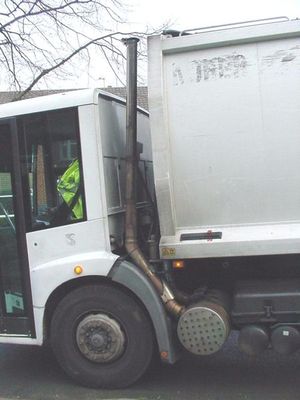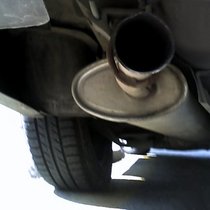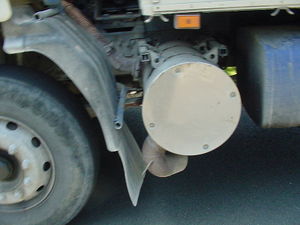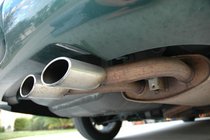Exhaust pipe
An exhaust pipe is usually tubing used to guide waste exhaust gases away from a controlled combustion inside an engine or stove. With an internal combustion engine it is usually part of an exhaust system. which conveys burnt gases from the engine and includes one or more exhaust pipes. Depending on the overall system design, the exhaust gas may flow through one or more of:-
- A turbocharger to increase engine power.
- A catalytic converter to reduce air pollution.
- A muffler (USA) / silencer (UK), to reduce noise.
Design criteria
An exhaust pipe must be carefully designed to carry toxic and/or noxious gases away from the users of the machine. Indoor generators and furnaces can quickly fill an enclosed space with carbon monoxide or other poisonous exhaust gases if they are not properly vented to the outdoors. Also, the gases from most types of machine are very hot; the pipe must be heat-resistant, and it must not pass through or near anything which can burn or can be damaged by heat. A chimney serves as an exhaust pipe in a stationary structure.
Motorcycles
In most motorcycles all or most of the exhaust system is visible and may be chrome plated as a display feature.
On a two-cylinder motorcycle, "siamese exhaust pipes" are where both cylinders blow into the same exhaust pipe. This usage is derived from "Siamese twin".
Trucks
In many trucks / lorries all or most of the exhaust system is visible. Often in such trucks the silencer is surrounded by a perforated metal sheath to avoid people getting burnt touching the hot silencer. This sheath may be chrome plated as a display feature. Part of the pipe between the engine and the silencer is often flexible metal industrial ducting, as in the image in the "Terminology".
Two-stroke engines
In a two-stroke engine, such as that used on dirt bikes, a bulge in the exhaust pipe known as an expansion chamber uses the pressure of the exhaust to create a pump that squeezes more air and fuel into the cylinder during the intake stroke. This provides greater power and fuel efficiency.
Ship's or large boat's onboard engine
With a ship's or large boat's onboard below-decks diesel engine:-
- Lagging the exhaust pipe stops it from overheating the engine room where people must work to service the engine.
- Feeding water into the exhaust pipe cools the exhaust gas and thus lessens the back-pressure at the engine's cylinders' exhaust ports and thus helps the cylinders to empty quicker.
Outboard motors
In outboard motors the exhaust system is usually a vertical passage through the engine structure and to reduce out-of-water noise blows out underwater, sometimes through the middle of the propeller.
Terminology
Manifold or header
In most production engines, the manifold is an assembly designed to collect the exhaust gas from two or more cylinders into one pipe. Manifolds are often made of cast iron in stock production cars, and may have material-saving design features such as to use the least metal, to occupy the least space necessary, or have the lowest production cost. These design restrictions often result in a design that is cost effective but that does not do the most efficient job of venting the gases from the engine. Inefficiencies generally occur due to the nature of the combustion engine and its cylinders. Since cylinders fire at different times, exhaust leaves them at different times, and pressure waves from gas emerging from one cylinder might not be completely vacated through the exhaust system when another comes. This creates a back pressure and restriction in the engine's exhaust system that can restrict the engine's true performance possibilities.
A header (sometimes called extractor in Australia) is another name for a manifold, specifically a manifold designed for performance. During design, engineers create a manifold without regard to weight or cost but instead for optimal flow of the exhaust gases. This design results in a header that is more efficient at scavenging the exhaust from the cylinders. Headers are generally circular steel tubing with bends and folds calculated to make the paths from each cylinder's exhaust port to the common outlet all equal length, and joined at narrow angles to encourage pressure waves to flow through the outlet, and not back towards other cylinders. In a set of tuned headers the pipe lengths are carefully calculated to enhance exhaust flow in a particular engine revolutions per minute range.
Headers are generally made by aftermarket automotive companies, but sometimes can be bought from the high-performance parts department at car dealerships. Generally, most car performance enthusiasts buy aftermarket headers made by companies solely focused on producing reliable, cost-effective well-designed headers specifically for their car. Headers can also be custom designed by a custom shop. Due to the advanced materials that some aftermarket headers are made of, this can be expensive. Luckily, an exhaust system can be custom built for any car, and generally is not specific to the car's motor or design except for needing to properly connect solidly to the engine. This is usually accomplished by correct sizing in the design stage, and selecting a proper gasket type and size for the engine.
Header-back
Header-back (or header back) is to the part of the exhaust system from the outlet of the header to the final vent to open air — everything from the header back. Header-back systems are generally produced as aftermarket performance systems for cars without turbochargers.

Turbo-back
Turbo-back (or turbo back) is to the part of the exhaust system from the outlet of a turbocharger to the final vent to open air. Turbo-back systems are generally produced as aftermarket performance systems for cars with turbochargers. Some turbo-back (and header-back) systems replace stock catalytic converters with others having less flow restriction.
With or without catalytic converter
Some systems (including in former time all systems) (sometimes nowadays called catless or no kitty) eliminate the catalytic converter, which may or may not be legal depending on place and whether the car will be driven on public roads.
Cat-back
Cat-back (also cat back and catback, and more recently axle back) refers to the portion of the exhaust system from the outlet of the catalytic converter to the final vent to open air. This generally includes the pipe from the converter to the muffler, the muffler, and the final length of pipe to open air.
Cat-back exhaust systems are a very popular aftermarket performance enhancement. They generally use larger diameter pipe than the stock system. Good systems will have mandrel-bent turns that allow the exhaust gas to exit with as little back pressure as possible. The mufflers included in these kits are often glasspacks, again to reduce back pressure. If the system is engineered more for show than functionality, it may be tuned to enhance the lower sounds that are lacking from high-RPM low-displacement engines.
Tailpipe and its tip
With trucks, sometimes the silencer is crossways under the front of the casb and its tailpipe blows sideways to the offside (right in UK, left in USA).
The end of the final length of exhaust pipe where it vents to open air, generally the only visible part, often ends with just a straight or angled cut, but may include a fancy tip. The tip is usually chromed, and is often of larger pipe than the rest of the exhaust system. This produces a final reduction in pressure, as well as prevents rusting of the tips, and can be used to enhance the appearance of the car. These are the least expensive parts of the system.
When a bus, truck or tractor or excavator has a vertical exhaust pipe, sometimes the end is curved, or has a hinged cover flap which the gas flow blows out of the way, to try to avoid foreign objects (including droppings from a bird perching on the exhaust pipe when the vehicle is not being used) getting inside the exhaust pipe.
In some trucks, when the silencer is front-to-back under the chassis, the end of the tailpipe turns 90° and blows downwards. That avoids anyone working by the truck when stationary from getting a directed blast of the exhaust gas, but often raises dust when the truck is driving on a dry dusty unmade surface such as on a building site.
See also
External links
- Exhaust Guide - detailed UK guide to exhaust systems
- Links to performance exhaust manufacturers


